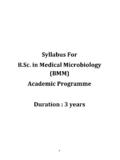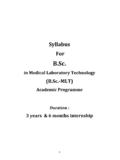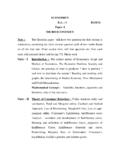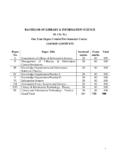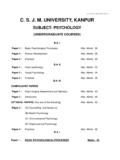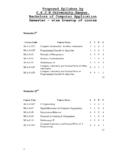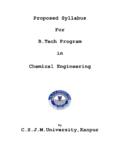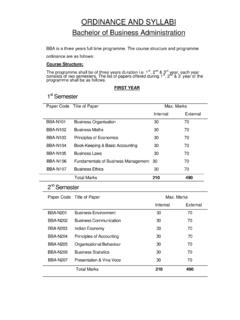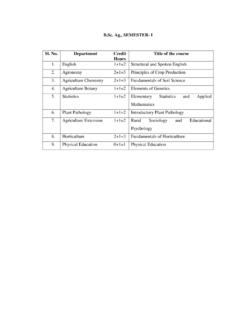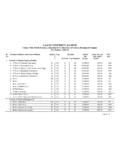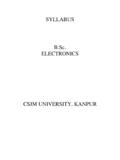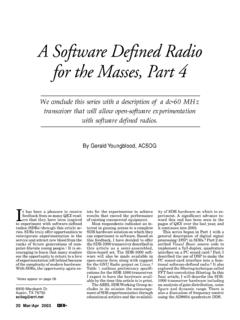Transcription of SYLLABUS B.Sc. INFORMATION TECHNOLOGY
1 SYLLABUS . INFORMATION TECHNOLOGY . CSJM UNIVERSITY, KANPUR. - I Year S. No. Paper Paper Name Marks Total 1. I INFORMATION Theory and Digital Electronics 50. 2. II Discrete Mathematics 50 200. 3. III C and C++ 50. 4. Practical MS Office and C/C++ Programming 50. implementing Data Structure - II Year S. No. Paper Paper Name Marks Total 1. I Software Engineering 50. 2. II Operating System 50 200. 3. III Database Concepts and System 50. 4. Practical SQL, PL/SQL and Shell 50. Programming(Unix). - III Year S. No. Paper Paper Name Marks Total 1. I Computer Graphics 50. 2. II Operation Research & Optimization 50 300.
2 Techniques 3. III Visual Programming and Web TECHNOLOGY 50. 4. Practical VB, HTML/DHTML, Graphics in C 75. 5. Project Project Report-Visual Basic, Web 25. Report TECHNOLOGY SYLLABUS . ( INFORMATION TECHNOLOGY ). PAPER- I. INFORMATION Theory and Digital Electronics UNIT- I: INFORMATION - Definition, Characteristics & Interpretation, Data & Its logical and physical concepts. UNIT- II: Computers: History of Computers and their classification, Basic Organization, Memory: Primary- RAM, ROM, EPROM etc. Secondary- Magnetic-Floppy and Hard Disks, Optical - CDROM, WORM etc. Concept of Virtual Memory and Cache Memory and why are they needed, I/O Devices, Computer Operation- Instruction Cycle, Program flow of control with and without interrupts, Computer Arithmetic- Number systems Decimal, Binary, Octal, Hexadecimal and their conversion, Binary Addition, Subtraction and Multiplication, Floating point representation and arithmetic, Computer Language- Introduction to computer language, Definition of assembler, compiler and Interpreter UNIT- III.
3 TeleCommunication- Concept of Analog and Digital Signal, Channel Capacity(Shannon's Theorem), Transmission Impairments, Concept of Signal to Noise ratio, Encoding/Decoding(Concept of Parity bit, Hamming Code), Transmission Media, A/D and D/A conversion, Modulation, Communication technique- circuit, message, packet switching- their advantages and disadvantages. Type of Networks (LAN, MAN, WAN etc), Topologies, Network configuration- Basic Protocols OSI, TCP/IP, Token ring, Internet- introduction to internet terminologies and concept of WWW, HTTP, E- mail, GIAS, Search engine, Domain name etc., FDM/TDM, Sampling theorem, PAM, PWM, PDM, PPM.
4 UNIT- IV: Digital electronic signals and switches- concept on digital signal, logic levels, Active high, Active low signals, Transistor. Logic Gates- AND, OR, NOT, NOR, EX-OR, EX-NOR operations and their truth table, Boolean Algebra and reduction techniques- K- Maps. Complement Subtraction Circuits- Half Adder, Full Adder, Half Subtracter , Full Subtractor, Various Code convertors. Multiplexers (MUX)- Working of MUX, Implementation of expression using MUX. Demultiplexers (DEMUX)- Implementation of expression using DEMUX, Decoder. FLIP FLOPS -Concepts, S-R, J-K, Preset &Clear, Master-Slave J-K D,T, Flip Flops with truth table Unit-V.
5 Introduction to 8085 microprocessor :-Organization of microprocessor based system, 8085 microprocessor Architecture , Concepts of Address line and memory interfacing, Instruction Format Modern day computer System :- Organization and Architecture, Structure and Function ,System buses ,Input/output modules, Concept of parallel processing Multiprocessing -Organization, Time-Shared Bus, Multiport Memory, Central Control Unit. Pipelining SUGGESTED BOOKS. 1. Computer Organization & Architecture Designing & Performance, William Stallings, Prentice Hall of India. 2. Computer Networks, Andrew , Prentice Hall of India.
6 3. George Kennedy, Electrical Communication System ,Tata McGraw Hill. 4. Digital Electronics-An Introduction to Theory and Practice, William , Prentice Hall of India. 5. Microprocessor Architecture and Programming and Applications with the 8085, , PRI. SYLLABUS . I ( INFORMATION TECHNOLOGY ). PAPER- II. Discrete Mathematics Unit-I. Fundamentals Sets and subsets, Operations on sets, Sequences, Division in the integers, Mathematical Structures. Logic Propositions and logical operations, Conditional Statements, Methods of Proof, Mathematical induction Unit -II. Counting Permutation, Combinations, Pigeon hole principal.
7 Relation and Digraphs Product sets and partitions , relations and digraphs, Paths in relations and digraphs, Properties of relations , Equivalence relations, Computer representation of relation and digraphs, Manipulation of relations , Transitive closure and Warshall's algorithm. Functions Function for computer science, Permutation functions growth of function Unit -III. Graphs Theory Graphs, Euler Paths and circuits, Hamiltonian paths and circuit coloring Graphs .Orders Relations and Structure Partially ordered sets External elements of Partially ordered sets , Lattices , Finite Boolean Algebra ,Functions on Boolean Algebra.
8 Unit - IV. Trees Labled tress, Tree searching, Undirected trees, Minimal spanning trees. Semigroups and groups - Binary operations, Semigroups , Products and quotients of semigroups, Groups and products and quotients of groups, Groups and Coding. Unit -V. Languages and Finite State machines - Languages, representation of special languages and grammars, Finite state machines , Semi groups, machines and languages, machines and regular languages. Groups and coding- coding of binary INFORMATION and error detection Decoding and error correction SUGGESTED BOOKS. 1. Discrete Mathematics,Schaum Series 2. Discrete Mathematics with 3.
9 Discrete Mathematics and its Application ,Kenneth SYLLABUS . ( INFORMATION TECHNOLOGY ). PAPER- III. C and C++. Unit - I. C Fundamentals- Character set, Identifiers and keywords, Data Types, Constants, Variables and Arrays, Declarations, Operators & Expressions, Library functions, Statements, Symbolic Constants, Preprocessor directives Data Input and Output- getchar(), putchar(), scanf(), printf(), gets(), puts() functions Control Statements- if-else, while, do-while, goto , for statements, nested control structures, switch, break, continue statements, comma operator Functions- Function prototypes, Passing arguments to a function by value, Recursion, Storage classes, Automatic, External, Static, Register variables in single file environment Arrays- Definition, Processing arrays, Passing arrays to functions, Introduction to multidimensional arrays, arrays and strings Pointers- declaration, referencing and de-referencing, passing pointers to functions, pointer to arrays.
10 Operations of files using pointers Structures and Unions. Unit - II. Data Structure- Definition and abstract data types, Stacks- definition, Array based implementation of stacks, Linked list, infix, prefix, postfix representation, Conversions, Applications. Queues , Dqueues and its implementation using C, Trees: Definition of trees and Binary trees : Properties ,Implementation ,Traversal pre-order ,post order ,In- order traversal. Threaded tree. Graphs & Sorting Algorithms - Graphs- Definition of Undirected and Directed graphs Graph Traversal Breadth first Traversal, Depth First Traversal, Array based implementation using C.
